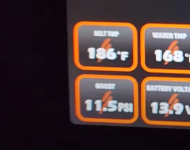Cracking turbo's? This is the first I have heard of it. Is this a widespread issue?
View attachment 86049
So, here's the thing... watch this vid:
You can see that the "boost" readout on the dash is most likely not boost, but Manifold Absolute Pressure (MAP). Arguably that is a mistake, or at least the display shouldn't be labeled as "boost."
Boost is commonly agreed to be the difference in manifold pressure as compared to current atmospheric pressure. I really don't think the thing is making 11.9psi of actual boost just putting around before he makes the pull (at about 12 seconds into the vid), it's probably 11.9psi MAP. What we're probably seeing is atmosphere (~14.7psi at sea level) minus some engine vacuum. Let's say at cruise like that it's pulling ~6 inHg, that's ~3 psi, so if he's around sea level the 11.9 displayed adds up (aka, something like 14.7psi of atmosphere minus 3psi of engine vacuum the manifold absolute pressure is around high 11s).
When he gets on it you see it goes to ~30psi, I'm pretty confident these things aren't running 30+ psi of actual boost stock, on 91 octane. To fully understand the screen cap above we need more data. They mention out first they were seeing 30 psi of boost, now 26... well I content that's MAP. And whether it is truly boost, or MAP I'm not sure how they get that a change from 30psi to 26psi is 8-10psi lost?
The other question is how the Speed controls boost. If they run a mechanical wastegate that is referenced to atmosphere a 4psi difference in atmospheric pressure (aka, change in altitude) would manifest as a 4psi change in MAP (what I believe is shown on the dash). So that could explain the change from 30psi to 26psi noted by RiverDave.
Now, I *ass*ume they actually use the ECU for boost (WG) control in which case I'd expect it to actually be indexed on MAP. With electronic boost (WG) control the ECU would be setup with MAP targets, not boost targets. If 30psi MAP is the WOT target at sea level the turbo only has to add ~15psi of "boost" to achieve that target, but at high altitude it would require more boost. Obviously there's a reasonable limit where the turbo will be too far out of its efficiency range and can't make up for extreme altitude. For example, the peak of Mount Everest still has ~4.5psi of atmospheric pressure, meaning the turbo would "only" have to make an "extra 10psi" to reach 30psi MAP as compared to sea level. I don't think anybody is taking a Speed to Mount Everest, so I imagine they have enough turbo to make up for any elevation they'd actually see.
FWIW my Turbo RZRs electronically controlled boost (as do X3s and I believe all factory turbo SxS/UTVs in general) and I saw exactly what I described going between Glamis and the Idaho Dunes: MAP at WOT was consistent which meant boost was higher in ID.
Now, the other intersecting thing from this video is the clutching. Note it's only pulling ~7,900 RPM at WOT for most of the pull. That seems low to me. My Turbo RZRs sure liked to pull more like mid-high 8ks for peak power, and I'd be surprised if the Speed doesn't as well. What I'm guessing is the clutching is setup for the Speed Key, which means they're leaving a lot on the table with the 91 setup. Still, TBH it gets up to 93 MPH pretty quickly. I've done ~85 in my last XPT which was a much lighter machine ('18 Fox edition 2 seat on only a 30" tire, not even the wider/heavier S model) and was modded/tuned and the Speed seemed to put on... well, speed just as quickly. I imagine tuning the clutch to optimize for 91 would make it a good bit quicker, but of course would have to be adjusted back for the Speed key.
Finally, WRT cracked turbos, honestly it doesn't shock me with an all new engine/turbo setup and the integrated manifold/exhaust housing. If it is a common problem I hope they get it sorted quickly and make the replacements easy to get for owners.
-TJ





